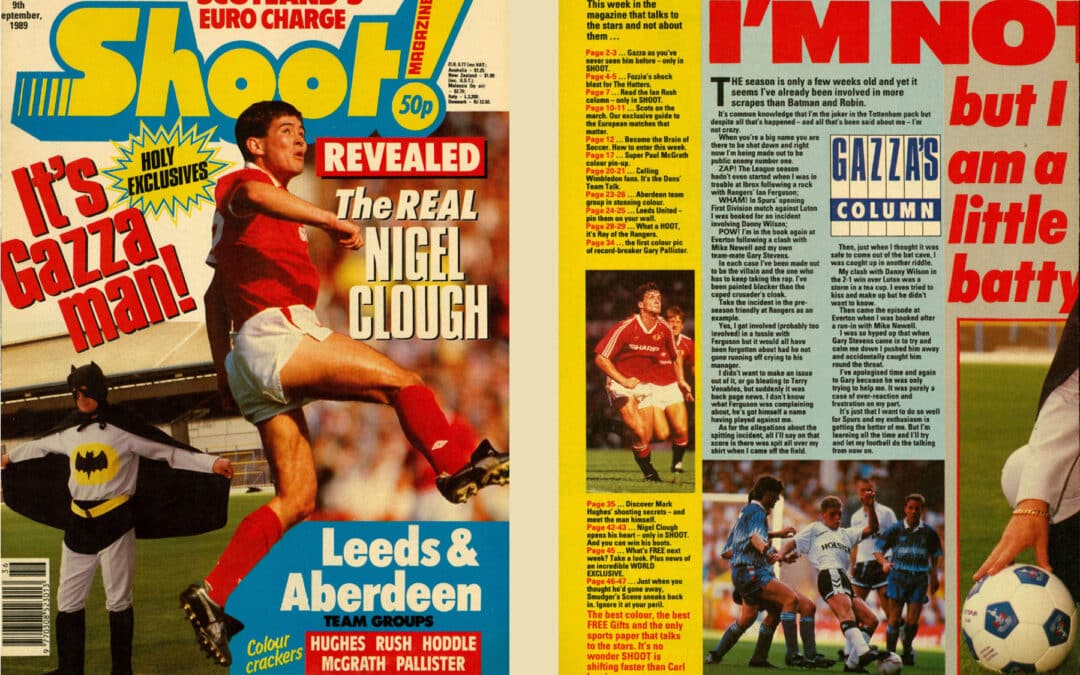Football magazines don’t make covers like they used to. Back in 1989, SHOOT magazine captured something magical—a snapshot of English football when personalities were larger than life and players spoke their minds without media training getting in the way.
The December 1989 issue wasn’t just another football magazine. It was a window into an era when Paul Gascoigne could freely admit to being “the Joker in the Tottenham team” and joke about being “in more scrapes than Batman and Robin.” This wasn’t corporate speak or carefully crafted soundbites—this was pure, unfiltered Gazza.
The Real Nigel Clough Behind the Headlines
While Gascoigne’s column grabbed attention with its trademark humour, SHOOT’s exclusive feature on Nigel Clough offered readers something equally valuable—an honest look at one of football’s most promising young talents. The Forest striker was making waves in the First Division, and SHOOT gave fans unprecedented access to the player behind the headlines.
Clough’s feature represented everything great about football journalism in the late 1980s. Writers took time to dig deeper, moving beyond match reports and transfer speculation to explore what made players tick. Readers got substance alongside the entertainment.
Gazza’s Unfiltered Voice
Gascoigne’s column in that September issue perfectly captured why he became such a beloved figure. His admission about being Tottenham’s joker wasn’t a calculated PR move—it was genuine self-awareness delivered with his characteristic wit. When he compared his mishaps to comic book heroes, fans could picture him grinning as he wrote it.
This kind of authenticity seems almost impossible in today’s media landscape. Players now have teams of advisors crafting their public image, social media managers filtering their thoughts, and legal departments reviewing their words. Gazza’s column reminds us what football lost when spontaneity disappeared from player communications.
When Football Magazines Mattered
SHOOT magazine’s 1989 September 9th issue represents more than nostalgia—it captures football at a pivotal moment. The game was becoming more professional, but hadn’t yet lost its rough edges. Players like Gascoigne could still be themselves in print, and magazines like SHOOT had the freedom to let personalities shine through.
These publications served as vital connections between fans and players. Without 24-hour sports channels or social media, magazines provided the in-depth access supporters craved. A Gazza column or Clough feature could define how fans saw these players for months.
The Legacy of Authentic Football Writing
Looking back at SHOOT’s September 9th 1989 issue, it’s striking how much personality comes through in just a few pages. Gascoigne’s self-deprecating humour, Clough’s thoughtful insights, and the magazine’s commitment to showing players as real people created something special.
Modern football media offers unprecedented access and instant updates, but rarely captures the authentic voices that made publications like SHOOT essential reading. Perhaps that’s why vintage football magazines continue to fascinate new generations of fans—they offer glimpses of when football’s biggest characters could simply be themselves.
That September 1989 issue of SHOOT remains a perfect time capsule, preserving Gazza at his most honest and football journalism at its most human. Sometimes the best stories come from letting personalities speak for themselves.

